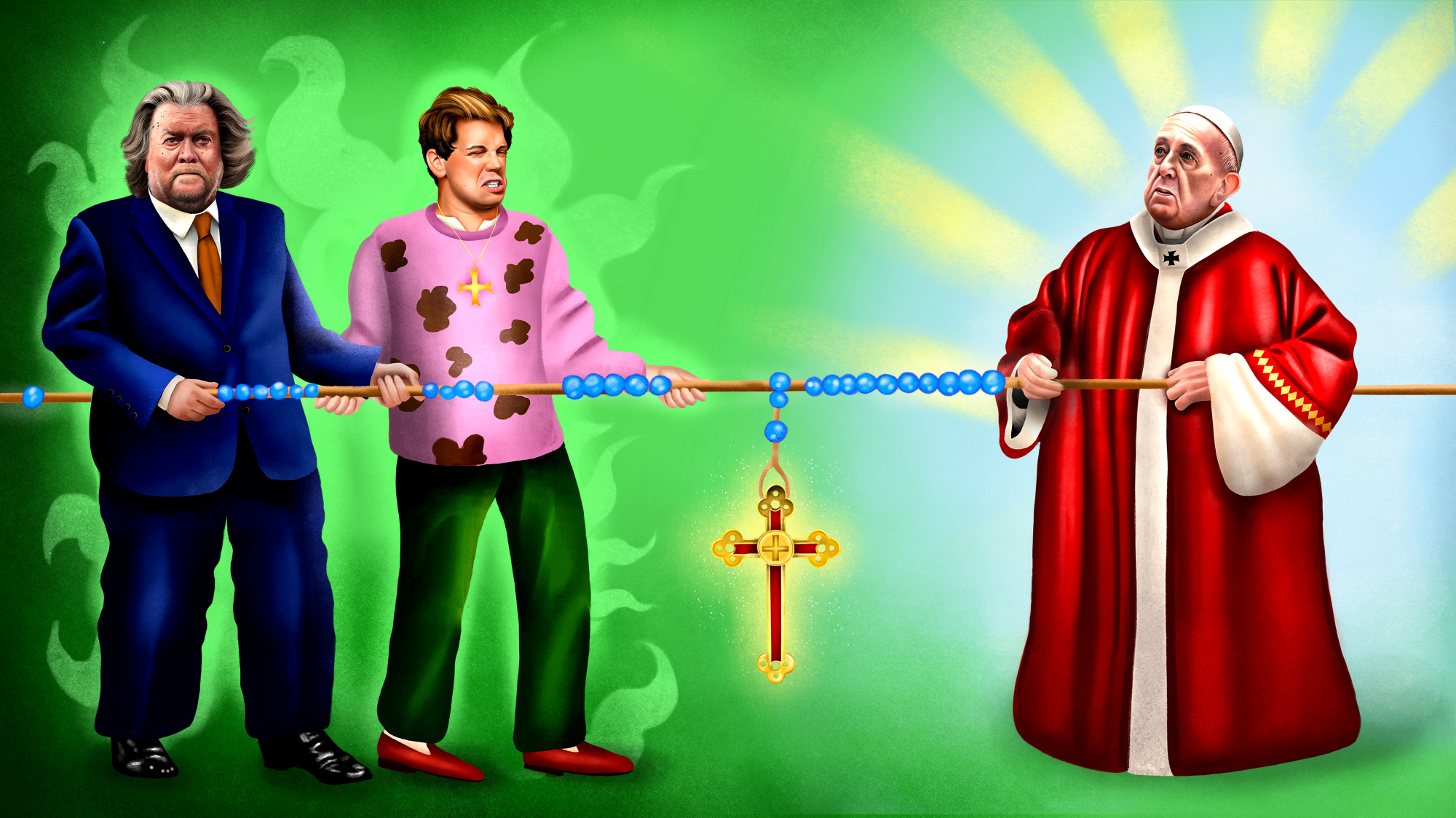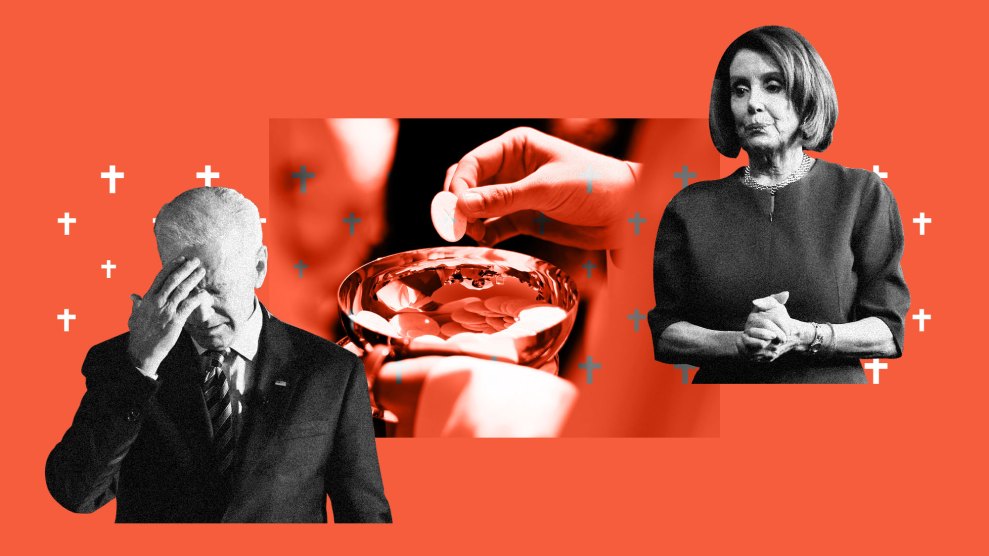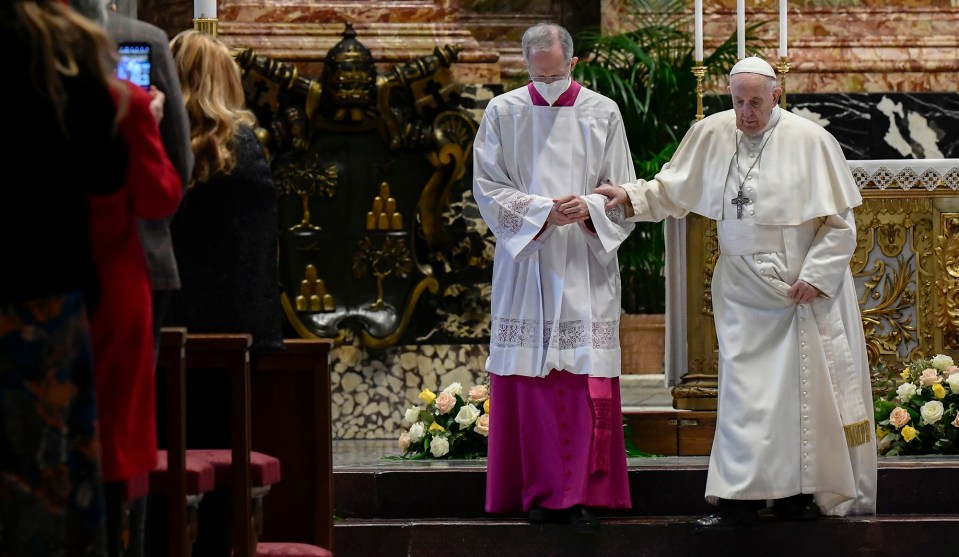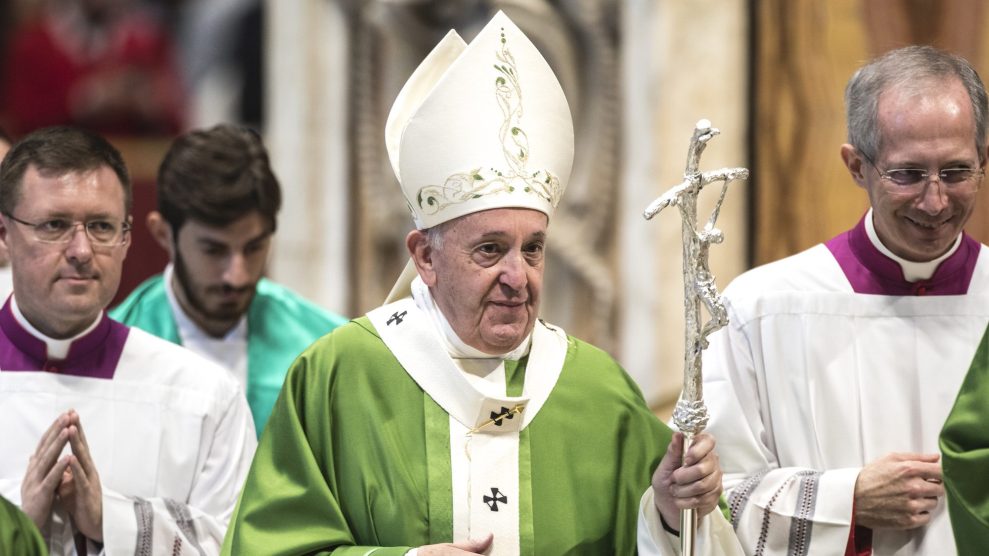At around the fifth hour of November’s “Enough Is Enough” prayer rally, hosted by the Catholic right media outlet Church Militant, event emcee and fallen alt-right star Milo Yiannopoulos bounded onstage to reveal a dramatic wardrobe change. Gone were the rock-star white suit and purple shoes he’d been wearing since morning, replaced by a black shirt, black suit, and heavy crucifix, which gleamed from the jumbotrons all the way to the back of Baltimore’s Pier Six Pavilion, where the concert venue jutted into the city harbor. The bleached-blond tips of his floppy hair—fashy-short on the sides and Donald Trump combover-long on top—had been shorn in a final makeover after his year of ostentatious renunciation.
At the podium, Yiannopoulos assumed an air of exaggerated modesty. “The path to salvation is a series of baby steps,” he told a crowd of some 1,500 predominantly white, mostly middle-aged rallygoers. “I’m glad I got to share one of them with you today.” Whooping and whistling, the audience rose in a standing ovation. And throughout the day, as Yiannopoulos interspersed homophobic slurs—like calling the Catholic bishops meeting next door “sodomites” and Covid masks “fag muzzles”—with banter about Versace loafers and demands for more flattering stage lighting, the crowd roared with laughter, all of them in on the joke.
There were, as they say, layers to this assemblage of some of the noisiest partisans in the ongoing civil war within the American Catholic Church.
On one level, Yiannopoulos was making the most of his fall from public grace. In 2015, the right-wing, gay, British provocateur gained notoriety as one of the chief devotees of the then-fledgling alt-right, using billionaire Republican donor Robert Mercer’s money and Steve Bannon’s Breitbart News platform to recast the white nationalist movement as edgy rebellion. Book deals, magazine profiles, and speaking gigs rolled in until comments he’d made minimizing child sexual abuse—defending sexual encounters between adolescents and adults as “enriching” rather than abusive—were publicized. That proved too much even for Milo fans who’d reveled in his offensiveness, and in 2017, he was drummed out of the ascendant far right.
For more articles read aloud: download the Audm iPhone app.
Over the next several years, he cast about for a new home. In 2018, he published a book, Diabolical: How Pope Francis Has Betrayed Clerical Abuse Victims Like Me—and Why He Has to Go, that tied his defense of the remarks he’d made—that he’d been glibly processing his own childhood sexual abuse—to the broader crisis in the Catholic Church. Soon, he was welcomed by right-wing Catholic news outlets like Church Militant and LifeSiteNews, and a popular Catholic apologetics YouTube show hosted by firebrand and now anti-vaccine activist Patrick Coffin, which together represent some of the most vitriolic critics of the pope online. In early 2021, Yiannopoulos completed the journey, announcing to LifeSiteNews that returning to a traditionalist form of Catholicism had helped him become “ex-gay,” and he now planned to build a Catholic-based conversion therapy clinic in Florida, to be called the Milo Center.
As Yiannopoulos conducted a publicity tour around the alternative media universe of the Catholic right, he theatrically threw away an engagement ring he called his “sodomy stone” and quipped about the need to “make the Vatican straight again” and “make America homophobic again.” By July, he’d become a regular columnist at Church Militant, where he paired his trademark acidity with a laser fixation on the “cult of homosexualism,” which he described as “a reimagining of a very old, pagan form of worship.” He also claimed that women who miscarry after receiving Covid-19 vaccinations have effectively aborted their children, and declared that “sometimes one feels the only good bishop is a dead bishop.” By fall, he was appearing on Church Militant’s home-shopping network, flogging an $88 “Adoring Virgin” icon—a “good Mary,” Yiannopoulos promised, unlike some less physically attractive depictions—and a CD set of him reading Psalms and Proverbs for $75.
In fact, Yiannopoulos’ high-camp style wasn’t out of place with the carnival of outrage that Church Militant has trafficked in for years. Originally founded in the early 2000s as Real Catholic TV, with a mission to rebut pop culture depictions of Catholicism like The Da Vinci Code, the organization has become increasingly political, garnering an audience of Catholics disaffected from official church leadership. Based in Ferndale, Michigan, Church Militant has been repeatedly disavowed by the Archdiocese of Detroit—including a successful 2011 demand to remove the word “Catholic” from the organization’s name. But it styles itself as an apostolate fighting to preserve authentic Catholicism in the face of a corrupt and milquetoast hierarchy, which it typically refers to with terms like “international crime syndicate” or “monsters in miters.”
Around 2018, when the church was roiled by revelations of sexual abuse by former Cardinal Theodore McCarrick, Church Militant zeroed in on what it called the “lavender mafia” to suggest that the sexual abuse crisis stems from a gay cabal controlling the church from the Vatican on down. Lately, the outlet has leveled its bombastic fury at pandemic public health measures and racial justice protesters and predicted Joe Biden’s presidency would result in an anti-Christian genocide. In 2020, the outlet’s founder, former CBS News producer Michael Voris—who has publicly renounced his own past same-sex relationships and mentored Yiannopoulos toward also embracing a “chaste life” (or what Yiannopoulos calls “sexual sobriety”)—warned that a “union of Rome and the Washington, DC swamp” was conspiring to oust Trump and usher in a new world order, under which faithful Catholics would be declared “illegal” and “hunted down.” Church Militant then relentlessly pushed stolen election narratives, and, as Trump supporters stormed the US Capitol on January 6, 2021, the outlet and its staff called them “patriots” and tweeted celebratory memes—like a diptych juxtaposing a photo of rioters hoisting a large wooden cross with the iconic image of Marines raising a flag at Iwo Jima.
Six months later, Church Militant announced plans to host a prayer rally, emceed by Yiannopoulos and headlined by former Trump adviser and right-wing Catholic Steve Bannon, who in 2018 launched an unsuccessful plan to build a “gladiator school for culture warriors” in partnership with a conservative Catholic think tank in Rome dedicated to “pushing back the tide of radical secularism.” Church Militant’s rally was to be held directly outside the November 2021 annual meeting, in Baltimore, of the US Conference of Catholic Bishops (USCCB), but city officials revoked the rally’s permit, arguing that the group’s presence could lead to violence. After a protracted legal battle, which included courtroom testimony from Yiannopoulos, who simultaneously offered to withdraw from the event and threatened to sue if he had to, an appeals court allowed the rally to go forward.
Not coincidently, the USCCB’s general assembly was gripped by a bitter debate about whether to recommend that pro-choice Catholic politicians like Biden be denied Communion. In the big picture, the outcome was essentially predetermined; local bishops, not the USCCB, decide who can receive Communion, and the cardinal overseeing Biden’s Washington church—America’s first Black cardinal, whom Church Militant derisively calls “the African Queen”—had already declared he wouldn’t deny Biden the sacrament. Not to mention the fact that the Vatican, where Biden received Communion in October after meeting with the pope, had long made it clear it wouldn’t approve denial even if the USCCB recommended it.
Nonetheless, back in June, two-thirds of the USCCB voted to draft guidance that might open the door to such recommendations—yet another expression of the intense division that permeates the US church, like the country itself. Such internal squabbles might not appear to be that significant. But the Catholic Church—with more than 1.3 billion members worldwide and representing the largest religious denomination in the US—has unparalleled political and social power. And the open civil war within Catholicism—with its undisputed center in the United States—has implications for everything from racism to climate change, women’s rights to right-wing nationalism, and whether one accepts science-backed public health measures and democratic elections, or violently rejects both.
A long-overlooked reality is starting to become clear: The ideological center of the Christian right—and thus the broader American right—springs at least as much from traditionalist Catholicism as from evangelicals who have commanded most of the public attention since the Reagan era. Or as historian Gene Zubovich puts it, “Catholics have become the brains of the religious Right in the US.”
The communion fight is just one of a series of Catholic-world bombshells in recent months, each of which would have been unimaginable a few years earlier. Last March, East Texas Bishop Joseph Strickland, a right-wing celebrity for his pro-Trump and anti-vaccination views, helped promote a plan to build a $22 million, 575-acre separatist compound for Catholics who view themselves as a besieged remnant of the church who must “preserve the faith” for future generations. (This plan is now on pause after its founder admitted to having an affair.) In May, 50,000 people registered for Patrick Coffin’s three-day anti-vaccination conference, which featured a bishop who suggested God will protect Catholics who refuse the Covid vaccine. It also included a priest warning that accepting vaccines—which he and many other right-wing Christians see as abortion-tainted for their distant connection to a decades-old fetal stem-cell line—would represent the first step toward replacing Christianity with “Dianic witchcraft.”
In July, a Wisconsin priest, James Altman—famous for declaring that Catholics who vote Democratic will go to hell, calling liberals “vermin,” warning parishioners to avoid vaccinations, and claiming that January 6 was a false-flag operation—was finally removed from his church and subjected to a formal review. Altman’s subsequent media blitz netted him a speaking slot at the Conservative Political Action Conference and more than $700,000 in donations, a chunk of which he promised to pass on to Church Militant and LifeSiteNews. Conservative Catholics launched two new coalitions for “canceled” and “persecuted” priests. Voris also assembled what he claimed were dozens of anonymous priests, unknown even to each other, into a group he called the New Catacombs, which could issue statements of dissent, ultimately fomenting a “revolution in the Church” by having so many clerics “denounce the evil in the hierarchy” that the bishops couldn’t fire them all at once.
And a retired archbishop, Carlo Maria Viganò, the Vatican’s former ambassador to the United States who went into self-imposed exile after calling for Pope Francis’ resignation in 2018, wrote an open letter suggesting that Catholics should pray for the Holy Father’s death.
Taken together, it’s enough to prompt numerous US Catholics to say they no longer recognize their religion. Or as conservative writer Jonathan Last noted in the Bulwark last spring, “It’s pretty safe to say that the culture war has broken the Catholic Church in America.”
To outsiders who haven’t followed the internal warfare prompted by the election of Argentine Cardinal Jorge Bergoglio to pope in 2013, all these fights must seem like a bewildering spectacle. But while Pope Francis is widely admired for his attention to poverty and the environment, and his occasional calls for moderation on “pelvic issues,” he’s harshly condemned by members of his own church. “Radical traditionalists,” who see the nearly 60-year-old reforms of Vatican II as the original sin of the modern era, view Francis as a heretical interloper. But even more mainstream conservative Catholics are also unhappy with the pope’s perceived liberalness, his focus on refugees, and his critiques of capitalist excess.
Michael Voris, who is considerably less bombastic in conversation than in his editorials, believes the fissures in the US church were 50 to 60 years in the making, and the only thing new is how public they’ve become. He sees Trump as having “taken what was already ongoing in the shadows, an under-the-radar battle,” and brought it into the open. “I really think it’s the theological tensions within the church that you’re seeing expressed,” he told me in 2020. “Those bubble up to the surface [when you’re] talking about social justice, immigration, or abortion, or whatever hot topic you want. But underneath every one of those, whichever side you choose is based on your theology.”
One way to tell that these tensions have reached a boiling point is that Trump—lacking a nuanced understanding of most things but possessing a sharky instinct for blood—noticed them. Throughout his reelection campaign, Trump bypassed the already conservative church hierarchy in favor of the dissident Catholic far right. He promoted figures like podcaster Taylor Marshall, author of the 2019 anti-Francis book Infiltration: The Plot to Destroy the Church From Within. Trump tweeted a link to an open letter that Archbishop Viganò had sent him, warning of a “deep church” collaborating with the “deep state” to undermine his presidency. After Trump’s defeat, Viganò joined Strickland and Marshall in addressing the December 2020 “Jericho March” in Washington, DC: an interfaith “Stop the Steal” prayer rally that was a precursor to the violence on January 6. In early January 2021, Viganò went on Steve Bannon’s podcast to say that the United States would be “wiped out” if it didn’t fight back against election theft.
And Trump relentlessly courted that constituency by appointing Catholic conservatives to the Supreme Court, including Amy Coney Barrett, who replaced the liberal feminist Ruth Bader Ginsburg.
Although the Catholic right represents a minority of the US church, it wields an outsize influence through a well-funded network of advocacy institutions and a parallel media ecosystem. Conservative and right-wing Catholics are highly represented in the US judiciary, and dominate the Supreme Court—seven current Supreme Court justices, including all three of Trump’s scotus picks, were raised Catholic, and six of those seven represent right-wing Catholic ideology. Their prevalence is the result of a long-running conservative project orchestrated largely by Federalist Society co-chair Leonard Leo. Leo is also president of the National Catholic Prayer Breakfast and founder of the Judicial Education Project (now called the 85 Fund), which funds a variety of right-wing advocacy organizations.
In a recent series of investigative articles, journalist Christopher White at the liberal National Catholic Reporter detailed how right-wing Catholic donors have turbocharged conservative think tanks and academic programs—such as a Catholic University of America business school named for its lead patron, the elite estate attorney and hotelier Tim Busch—and funneled millions of dollars into election efforts like a voter-suppression initiative founded by Catholic-aligned anti-abortion organizations. In turn, as Brian Fraga reported at NCR this January, conservative Catholic groups and institutions have received millions from the “dark money” Donors Trust network, which funded both white nationalist organizations and right-wing political groups that helped organize the protests of January 6.
Fringe but high-traffic media outfits like Church Militant, and more mainstream ones like cable giant EWTN (Eternal Word Television Network), the world’s largest religious media network, with a claimed viewership of 380 million households across more than 150 countries, thrive in the Catholic media landscape. As with their secular counterparts like Fox News—which regularly borrows EWTN’s star anchor, Raymond Arroyo, as a co-host for The Laura Ingraham Show—stories born on the fringe have a tendency to creep into the center of the Catholic media universe, commanding audiences far larger than those of the original outlets.
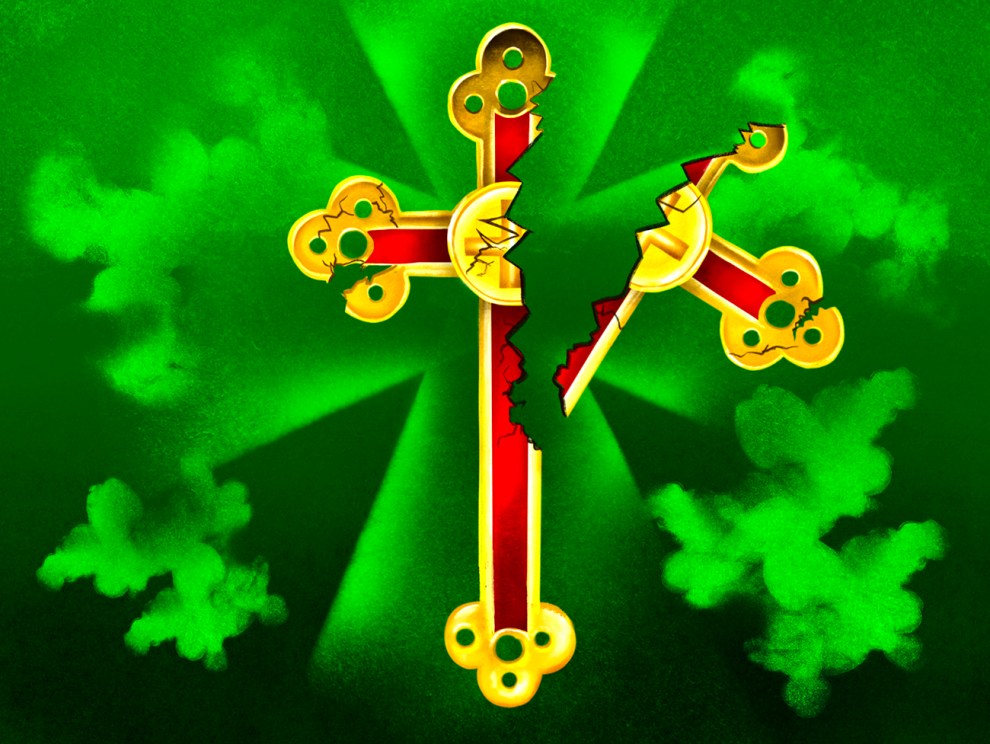
“The English-speaking Catholic media is dominated by a few, very powerful outfits, and many of them have been very opposed [to the pope] in overt, blatant ways,” Christopher Lamb, author of the 2020 papal biography The Outsider, tells me. EWTN has given uncritical platforms to figures like Bannon (who has called the pope a “Marxist Jesuit that’s in bed with the Chinese Communist Party,” and accused him of enabling “cultural Marxism” to infiltrate the church) and Cardinal Raymond Burke, one of the pope’s most outspoken critics within church hierarchy; in 2019 it even live-broadcasted a priest’s anti-Francis homily.
In September, shortly after undergoing surgery, Francis publicly said he was “still alive, even though some people wanted me to die,” and referred to EWTN, saying, “There is, for example, a large Catholic television channel that has no hesitation in continually speaking ill of the pope.”
That relentlessly critical portrayal of the pope doesn’t represent the majority of US Catholics, 82 percent of whom, according to a Pew Research poll, have favorable impressions of Francis. But the negative reporting takes its toll, says Mike Lewis, founder of the moderate Catholic website Where Peter Is, which tracks and rebuts the Catholic right: “Unlike evangelicals who can start their own churches, the Catholic Church is restrained to some degree by the hierarchy, which is restrained in theory by the pope. The only problem is there’s an increasing number of Catholics in this alt-right movement who defer in absolutely no way to the hierarchy. Or who, rather than their local bishop…look to Viganò, Burke, and Strickland as their leaders.” And “because of social media and outlets like EWTN and LifeSiteNews,” Lewis adds, “they get a disproportionate amount of attention compared to their actual authority.”
“The problem is that the extreme right-wing is an expression of something that is not just crazy people but is visible also in the official clerical culture of the [US] Catholic Church,” says Massimo Faggioli, a church historian at Villanova University. “There are bishops whose language is more diplomatic, but they express the same contempt for Francis, the same fascination for the neo-nationalist project.” Add to this dynamic the “intellectuals blowing on this fire,” he says, “because they think the liberal, cosmopolitan international order must be burned down. That’s their very dangerous plan…and sadly, liberal Catholics have no plan.”
At the “Enough Is Enough” rally in Baltimore, all of these tensions were on prominent display. The bishops meeting at the Baltimore Waterfront Marriott were taunted by Church Militant’s rallygoers stationed a few hundred feet away and chanting, “Shame on you,” “Repent or resign,” and “Lock them up.”
On its face, the rally focused on Church Militant’s suspicion—which proved to be correct—that bishops would not move to deny Biden Communion. But the complaints from those who attended were much broader, seen in protest signs reading “Covid-19 Vaccines are made from aborted babies” and “Enough Is Enough: Stop the Homo-Heresy!” Near the back of the pavilion, a New Jersey man was elaborately costumed as a “wolf in priest’s clothing,” a large cardboard millstone around his shaggy wolf neck.
Although Bannon didn’t appear—he’d been arrested the day before in conjunction with the House January 6 investigation, a development that one attendee, who wore a Star of David button reading “vaccine passport,” attributed to USCCB machinations—a cast of other Catholic right dissidents was paraded before the crowd. James Altman was part of a panel of “persecuted priests,” who claimed they’d been sidelined for speaking out against liberal bishops. Patrick Coffin also made an appearance, speaking by remote feed because he refused to wear a mask on any plane that might take him to Baltimore. Radio evangelist Jesse Romero, a former member of Trump’s Catholic election advisory board, claimed that the bishops were in league with “Luciferians who want to control and depopulate the earth.” Former Newsmax host Michelle Malkin, fresh from her appearance at a white nationalist conference run by the group American Renaissance, argued that USCCB advocacy on behalf of immigrants amounted to an open-borders agenda intended to “destroy the historical American nation.”
In the audience, rallygoers expressed their own grievances. A Detroit man said he was there to pressure bishops to ensure that people who support abortion, gay marriage, and socialism don’t receive Communion. An Arizona attendee said his entire family had left Catholicism because lax churches had failed to catechize them properly. And a Maryland woman with a Star of David button, whose business card read “housewife, mother, peasant,” told me, “It’s really hard to watch your children going astray because there’s no voice, nobody backing you up in your beliefs.” The great divide in the church, she said, mirrored the one in the country at large, and she had little hope it would mend soon. “It’s just feeling like we’re falling apart.”
But if a sense of despair hung in the air, Church Militant wanted to transform it into action. As the rally neared its sixth hour, Joseph Gallagher, the young head of Church Militant’s action arm, Resistance, called on attendees to “get dirty” fighting at the local level: by picketing bishops to reinstate “canceled priests,” bringing Yiannopoulos to college campuses to preach about “praying the gay away,” or counter-protesting at a memorial for George Floyd to highlight the “real racial injustice” of abortion. Imploring the audience to transcend social media distractions in favor of righteous extremism, Gallagher said, “I don’t want to look back and think, ‘What more could I have done to not allow this to happen?'”
While Church Militant may remain the dubious, disreputable stepchild of the broader conservative Catholic world, its influence is indicative of a larger shift. Last year, the National Catholic Reporter ran a story about how a new crop of intensely right-wing priests is dividing Catholic parishes around the country. One older priest was quoted as saying these young priests, immersed in right-wing politics and social media, sometimes even willing to tell parishioners who to vote for, were following “an alternative magisterium” they’d found online, on websites like Church Militant. Some parishes now face an odd reversal of the post–Vatican II era, as liberal and moderate Catholics are sent searching for a church that reflects their values, some even compelled to hold ad hoc Masses in auto-repair garages, in the face of a growing hyper-orthodoxy in their former parishes.
While US Catholic Church membership has dropped overall by nearly 25 percent in the last 20 years and vocations for priests and nuns have fallen as well, church traditionalists crow that their seminaries are receiving more applicants than they can accept—part of a trend that could accelerate the spread of Catholic right ideas. “In a shrinking Church, the influence of its more committed members will wax, not wane,” conservative Catholic journalist Ross Douthat wrote in the right-wing Christian journal First Things last summer. “In a smaller, weaker Church, the influence of ideas that seem weird to the average Catholic today are likely to be magnified, as the Church becomes more an institution by, for, and of the weirdos.”
As night fell in Baltimore, the landmark neon sign of the Domino Sugar refinery flicked on, and the final event of the day began: a mock trial of the bishops meeting next door. They were collectively charged with committing seven grave offenses, including “destroying the patrimony of Holy Mother Church.” As the dwindling crowd roared its verdict at each “charge,” Voris exhorted them, “This is for keeps. You should leave this rally…intent to make the remainder of your life’s work the purification of the church, regardless of what it costs you, regardless of what time you have to spend…It is your duty to combat that evil, and to combat it with your last breath if necessary.” Then he invited them to cross the bridge from the pier to the Marriott hotel so they might remind the priests meeting there “how hot hellfire actually is.”
